A Comprehensive Exploration of Zircon: Properties and Uses
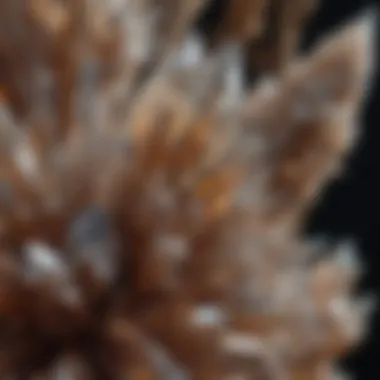
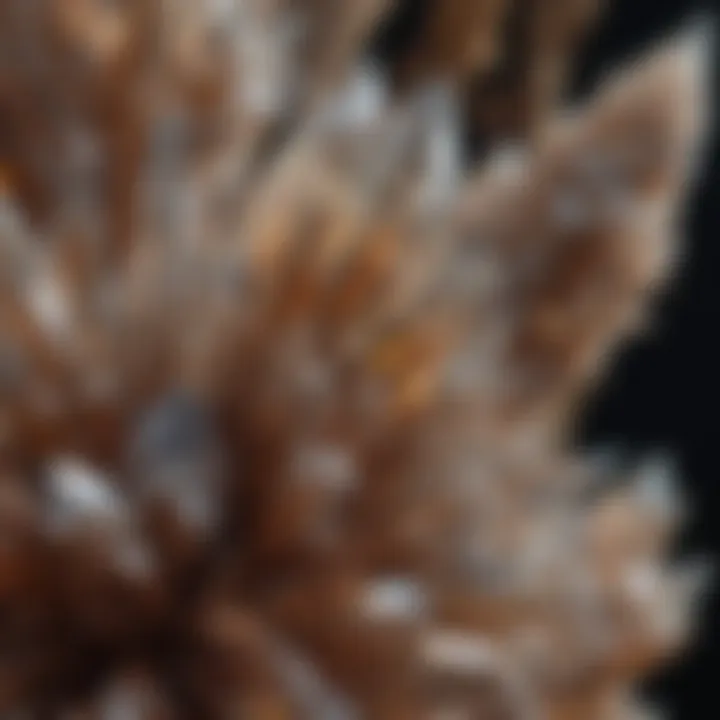
Intro
Zircon is much more than a mere gemstone; it is a vibrant piece of Earth's tapestry, steeped in millions of years of geological history. Found in a variety of colors including transparent, yellow, blue, green, and even red, zircon captivates collectors and researchers alike. Understanding this mineral requires unraveling its layers—from its intriguing chemical compositions to its transformation into various forms.
Often mistaken for other stones like cubic zirconia, zircon boasts distinct qualities that set it apart—both in aesthetics and significance. It's been a cornerstone in geological research, providing insights about the Earth's formation and its evolving landscape. In the realm of gemology, zircon's brilliance and fire make it a beloved choice among jewelers and enthusiasts.
As we embark on this journey, let’s delve into the multifaceted nature of zircon, spotlighting its essential components, applications, and the narrative that ties it to both our cultural heritage and scientific advancements.
Understanding Zircon
Zircon, though often overshadowed by its more famous gemstone rivals, is an extraordinary mineral that deserves its place in the spotlight. Understanding zircon goes beyond mere identification; it encompasses a recognition of its role in both geological formations and the commercial jewelry industry. The importance of this understanding lies not only in the practical implications for collectors and enthusiasts but also in its historical and scientific significance. As we peel back the layers of zircon’s characteristics, its trajectory through time, and its applications today, we come to appreciate its complexity and value.
Definition and Basic Characteristics
Zircon is a mineral primarily composed of zirconium silicate, represented chemically as ZrSiO4. It often forms in equant or prismatic crystals and can exhibit a dazzling range of colors, including colorless, yellow, green, brown, and red. The specific colors often depend on impurities and the conditions under which zircon develops.
One striking feature is its versatility; zircon can be found in igneous, metamorphic, and sedimentary rocks. Its crystallized structures are known for their durability, making it a particularly interesting subject for gem enthusiasts who seek both beauty and resilience in gemstones. Another distinct trait is its high refractive index, which allows zircon to sparkle intensely, akin to diamonds, although its origins are vastly different.
"Zircon is like the unsung hero of the gemstone world, quietly shining amidst its glamorous competition while packing a punch in its history and significance."
Historical Context
The journey of zircon is steeped in human history. Its first known mention dates back to ancient times, where it was often mistaken for other gemstones. References to zircon can be found in the literature of ancient civilizations, where it was utilized not only for decorative purposes but also believed to hold protective qualities. Medieval lapidaries often valued zircon for its supposed ability to help sleep and ward off evil.
Digging deeper into its geological narrative, zircon is one of the oldest minerals on Earth, with some crystals found to be over 4 billion years old. These primordial specimens are crucial for geologists as they provide vital clues about Earth's early environment and the processes that formed it. Zircon stands as a testament to the planet's history, telling tales of volcanic eruptions and the tectonic movements that shaped the continents.
As we explore the significance of zircon in our modern context, its historical roots remind us of our longstanding fascination with this remarkable mineral. The next sections will delve into its chemical structure and physical properties, unveiling the very elements that contribute to zircon's uniqueness.
Chemical Composition
Understanding the chemical composition of zircon is fundamental to grasping its significance in both geology and gemology. At its core, zircon is a mineral primarily composed of zirconium silicate, with the chemical formula ZrSiO₄. This simple yet complex formulation contains zirconium, which plays a crucial role in various scientific applications, from geology to materials science. Its unique composition accounts for the mineral's remarkable properties, making it desirable for collectors and researchers alike.
Zircon's structure is not merely a random assemblage of elements; it represents a specific arrangement that contributes to its stability and versatility. Analyzing its chemical composition provides insights into its durability, optical characteristics, and general behavior in different environments.
Crystal Structure
Zircon crystallizes in the tetragonal system, resulting in a distinctive crystal habit. The tectosilicate framework allows for a robust interlocking arrangement of zirconium and silicate tetrahedra. This formation is what gives zircon its strength and durability. Just as a well-constructed building withstands time, the crystal structure of zircon ensures that it endures geological processes, making it one of the oldest minerals found on Earth, with ages exceeding 4 billion years.
The crystal lattice of zircon is not homogeneous. It can incorporate various cations, such as hafnium, thorium, and uranium, in addition to the primary components. This ability to tolerate other elements provides zircon with its fascinating variety of forms and hues. Its transparency and beauty are further enhanced by this crystalline arrangement, being a sought-after choice in jewelry.
Elemental Composition
Delving deeper into a zircon's elemental composition reveals a rich tapestry of colors and variations. Zircon typically contains between 66% and 67% zirconium oxide, 28% to 29% silicon dioxide, and trace amounts of other oxides that alter its properties. Elements like hafnium and uranium can be significant, influencing both the mineral's formation and its applications in nuclear geology.
The elemental composition directly affects zircon's resilience. High levels of zirconium lead to exceptional hardness on the Mohs scale, often rated between 6 to 7.5, depending on impurities. As the purity of zircon increases, its potential for various applications rises too. A closer look at zircon's make-up showcases variability in:
- Color: Depending on trace elements, zircon can appear in a spectrum from clear to vibrant hues like blue, yellow, and green.
- Density: Pure zircon has a specific gravity that ranges significantly based on its composition.
- Optical Properties: The presence of different elements impacts how light interacts with zircon, leading to its use in the creation of high-quality gemstones.
In summary, the chemical composition of zircon is a critical factor that underpins both its geological significance and commercial value. With a fine balance of elements, zircon serves as a practical resource in various fields and a beautiful addition to any collection.
Physical Properties
Understanding the physical properties of zircon is crucial when examining its significance in both geological and gemological contexts. These properties not only define how zircon behaves when subjected to environmental factors but also play a pivotal role in its identification and classification. Knowledge of zircon’s physical traits assists collectors and scientists alike in evaluating the mineral's quality, origin, and durability.
Color Variations
Zircon comes in a dazzling array of colors, ranging from colorless and yellow to green, brown, and even rarer shades like blue and red. These variations arise from trace elements and their interactions during the formation process. For instance, typically a small amount of uranium or thorium can add a yellow or amber tint. In contrast, the captivating blue hues often result from heat treatment, a process widely employed in the gem industry.
Here’s a fascinating point – the color can serve as a guide in determining the zircon's provenance. Collectors should be keen to recognize that certain colors can be more desirable or valuable than others. For example, blue zircon is especially prized, often confused with tanzanite or topaz due to its vibrant hue. Within the context of geology, different colored zircon can suggest varying environmental conditions during its crystallization, indicating the geological history of the area where it was found.
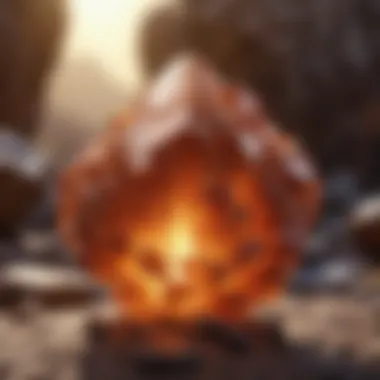
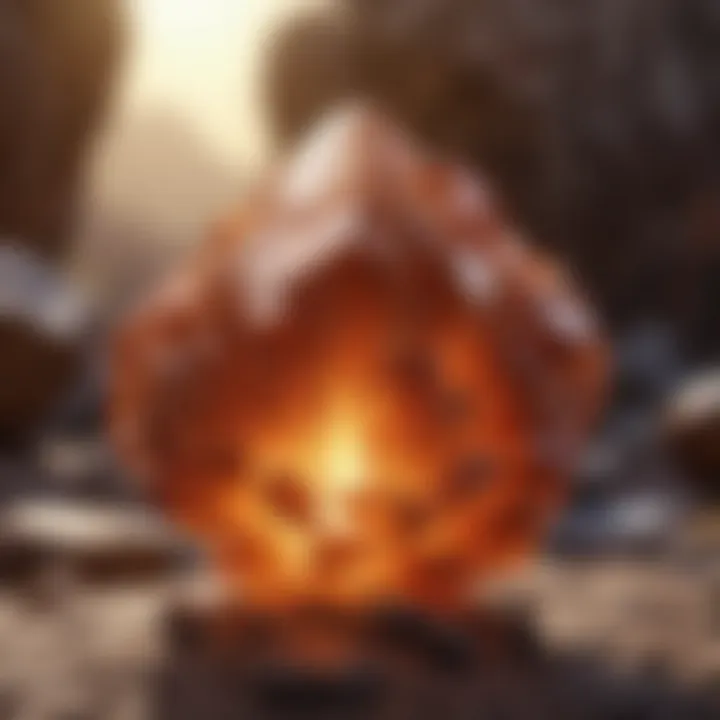
Hardness and Durability
When assessing the wear and tear of zircon, hardness is a critical factor. Zircon rates between 6 to 7.5 on the Mohs scale, which positions it as a relatively durable gemstone. Though not the hardest mineral available, it is certainly more resistant to scratches than other popular gemstones, making it suitable for various types of jewelry.
Moreover, zircon's toughness should not go unnoticed. It withstands high pressures and temperatures, an attribute that enhances its desirability in both commercial and industrial settings. Collectors should take particular note: this resilience means that even ancient zircon, which has endured geological transformations, can still retain its beauty without significant degradation over millennia.
For rock hounds, distinguishing characteristics such as these firmly establish zircon as a premier choice for collectors seeking an eye-catching specimen that stands the test of time.
Optical Properties
The optical properties of zircon are remarkable and contribute significantly to its allure as a gemstone. Zircon exhibits strong birefringence and is known for its brilliance, offering a sparkle and fire that attracts enthusiasts and gemologists alike. When light passes through zircon, it refracts and disperses, akin to what is witnessed with diamonds.
These optical characteristics can be attributed to its crystal structure, which allows for unique light interactions. As a result, zircon can exhibit a variety of visual effects, including the unique phenomenon known as "pleochroism", where the mineral appears to change color when viewed from different angles.
For those wishing to identify or evaluate zircon, understanding these optical properties can be immensely helpful. Brightness, clarity, and the stone's response to light serve as key markers in distinguishing genuine zircon from imitations. Recognizing these features ensures that collectors can make informed choices and build impressive mineral collections.
"Zircon not only dazzles with its beauty but also narrates the story of the Earth through its physical properties."
Collectively, the physical properties of zircon — its color range, hardness, and optical characteristics — form a rich tapestry that reflects not just the mineral’s aesthetic appeal but also its geological significance. These attributes are essential for both collectors and scientists in appreciating the multifaceted nature of zircon.
Geological Significance
The significance of zircon within the geological arena can't be overstated. It's not just a pretty stone; it's essential in understanding the evolution of our planet. Zircon forms in magmatic environments and is often found in igneous rocks, making it a prime subject of study for geologists exploring the Earth's crust. Through its study, scientists can glean insights into the conditions and processes that occurred during Earth's formation.
Formation Processes
Zircon crystallizes from magma cooled slowly beneath the Earth's surface, typically in environments rich in silica and alumina. Over time, this process can lead to a variety of zircon deposits found in sedimentary rocks, resulting in what we call detrital zircon.
- Igneous Zircon Formation:
- Sedimentary Zircon Formation:
- Under high temperatures, zircon can form in granitic and syenitic environments.
- As magma rises and cools, zircon crystals can grow in size and complexity.
- Erosion of zircon-rich rocks transports zircon grains into river beds and other sedimentary environments.
- These grains can provide a record of the geological history of a region, as they can be very old, surviving multiple geological processes.
Through radiometric dating techniques, particularly uranium-lead dating, scientists can determine the age of zircon crystals, offering a snapshot of when and how the minerals formed.
Zircon as a Geological Indicator
The role of zircon as a geological indicator is critical. Because it can withstand extreme conditions—both thermal and chemical—zircon is often unaltered in the face of metamorphism. This resilience provides geologists with data on the temperature and pressure at which the host rocks formed.
It also carries a chemical signature that can indicate:
- Tectonic Environments:
- Source Rock Characteristics:
- The presence of specific trace elements points to the geological processes involved, such as subduction or continental collision.
- Variations in zircon composition can highlight the provenance of sedimentary layers.
"Zircon is more than a beautiful gem; it acts as a time capsule, reflecting the dynamics of Earth's history."
Zircon in Earth's History
Zircon's history is a tale of survival and transformation. The oldest known minerals on Earth, some zircons date back over 4 billion years, providing a glimpse into the Hadean period of our planet. These ancient crystals help scientists unlock information about:
- Early Earth Conditions:
- Continental Crust Evolution:
- By studying these primordial zircons, researchers can infer the temperature and composition of the early Earth’s crust and atmosphere.
- Zircon growth patterns strip new insights into how continents have formed and developed over geological time scales.
Understanding zircon is akin to peering into Earth’s past, helping us chart the evolution of our planet in a way that few other minerals can. Its geological significance stretches beyond mere dates; it is a rich source of information about the Earth’s formative years and the processes that shaped it.

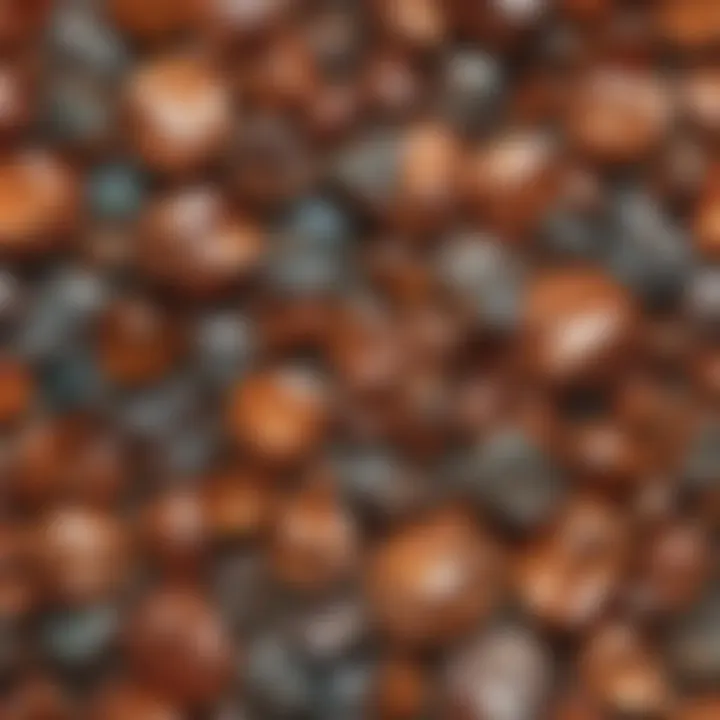
Uses and Applications
Zircon has carved a niche for itself across various sectors, making its exploration a rewarding venture for rock and fossil collectors and enthusiasts alike. Understanding its diverse applications not only enhances our knowledge of this remarkable mineral but also illuminates its significance in both commercial and scientific realms.
Commercial Use in Jewelry
Zircon is often mistaken for diamond due to its brilliance and sparkling finish, yet it carries its allure in a distinctively unique light. Unlike imitations, such as cubic zirconia, natural zircon is appreciated for its rich history and geological significance. Jewelers favor zircon, particularly in the creation of elegant rings and necklaces, due to its spectacular color range—from sea blue to golden yellow and even earthy browns that catch the eye.
When talking about jewelry, it's crucial to consider the quality of the stone. The highest quality zircons, often referred to as 'Matura' zircons, come primarily from Sri Lanka and are highly coveted. The durability and ability to withstand wear make them a reliable choice for daily wear accessories. Potential buyers should be aware that while zircon is resilient, it still requires proper care to maintain its luster, which brings us to understanding its care and preservation.
Industrial Applications
Beyond the glitters of the jewelry world lies zircon's remarkable journey into industrial sectors. It plays an indispensable role in manufacturing high-performance ceramics. Due to its thermal stability, zircon serves as an essential raw material for the production of refractory materials, which withstand high temperatures without melting or deforming. This makes zirconan invaluable component in industries ranging from glass manufacturing to aerospace technology.
Moreover, zircon's unique properties allow it to be used in the production of pigments and coatings that require high opacity and durability. It’s also worth noting that some chemical processes utilize zirconium, derived from zircon, as a crucial compound in various catalytic reactions, further emphasizing its versatility.
Role in Research and Science
The scientific community has taken a keen interest in zircon for its invaluable contributions to geological research. Zircon crystals are often the most studied minerals because of their ability to retain information about geologic processes over billions of years, acting as time capsules. This makes them vital in understanding the Earth's history and evolution.
"Zircons not only help us date geological events, but they also preserve signatures of processes that affected the Earth in its formative years."
Ranging from dating techniques like uranium-lead dating to elucidating metamorphic processes, research involving zircon has paved the way for deeper insights into our planet's behavior. Not to mention, this mineral also assists researchers in exploring possibilities of finding life on other planets. The ability of zircons to reveal the environmental conditions of their formation adds a layer of intrigue that keeps scientists engaged.
In summary, zircon's multifaceted applications span a plethora of fields, demonstrating not only its commercial viability but also its immense scientific value. Each use case adds to the overall narrative of zircon, illustrating its role as a mineral of great importance in both everyday life and specialized research.
Identification of Zircon
Recognizing zircon accurately is crucial not only for collectors but also for researchers and gemologists alike. Zircon's unique properties demand a keen eye and a methodical approach to distinguish it from similar minerals. This section covers pivotal techniques for identification, exploring the benefits of each method, and what considerations should be kept in mind during the examination process.
Visual Inspection Techniques
When it comes to visual inspection, the magic often lies in the details. Armed with just your eyes, you can gather significant information about zircon. Here are a few pointers to get started:
- Color Assessment: Zircon can come in a rainbow of hues; from deep blues to fiery reds. While color is not always a foolproof identifier, it offers critical clues. For instance, blue zircons are often confused with blue topaz.
- Luster Observation: Zircon is known for its brilliant luster that can range from adamantine to vitreous. Holding a piece under a light source can reveal this vital characteristic.
- Birefringence Examination: When viewed under polarized light, zircon displays noteworthy birefringence. This means that, through a polarizing filter, the gem can appear to show more than one color or shadow.
- Inclusions and Internal Features: Inspecting for inclusions might unveil unique patterns inside the zircon, hinting at its formation story. Typical inclusions to look for include needle-like structures known as "zig-zag twinning".
"Attention to the minutiae can often guide one closer to excellence in identification, especially in intricate specimens like zircon."
Laboratory Analysis Methods
For a more definitive identification, laboratory analysis often provides the clearest answers. Professional testing techniques can decode the complexities of zircon, giving a comprehensive picture. Here are common methods used in laboratory settings:
- X-ray Diffraction (XRD): This method helps to determine the crystalline structure of zircon and can differentiate it from similar minerals based on unique diffraction patterns. The results from XRD can be quite telling—if zircon's peaks show different orders, you've got yourself a true specimen.
- Energy Dispersive X-ray Spectroscopy (EDX): EDX can analyze the elemental composition at a microscopic level, allowing gemologists to pinpoint specific trace elements in zircon that differentiate it from its imposters. For example, the detection of hafnium could suggest the sample is indeed zircon.
- Raman Spectroscopy: This non-destructive technique provides detailed information about the mineral's chemical composition. It can unveil even the slightest discrepancies that an untrained eye might overlook.
- Thermal Emission Spectroscopy: By measuring the mineral's response to heat, this method can provide insights into the thermal properties of zircon, giving indications of its stability and origin.
Through these techniques, the nuanced world of zircon can be better understood, further amplifying the importance of careful identification in both geology and gemology.
Rarity and Varieties
Rarity and varieties of zircon play a crucial role in understanding its significance both in gemology and geological studies. Collectors and enthusiasts often seek out unique forms of zircon, making them highly valuable over time. Recognizing the diversity and availability of zircon is essential for anyone interested in this captivating mineral.
Types of Zircon
When we discuss the types of zircon, it’s essential to remember that this mineral can present itself in various forms, each bearing distinct characteristics:
- Ordinary Zircon: Commonly found, this type is often used in jewelry. It can be colorless, yellow, green, or brown and is primarily recognized for its brilliance and fire.
- Blue Zircon: Known for its vibrant blue hue, it’s one of the most sought-after types in the gemstone market. Its striking appearance, however, comes with certain treatments that enhance the color.
- Green Zircon: This variety presents earthy tones. While less popular than blue, its unique natural tones attract collectors looking for unaltered stones that tell a story of their formation.
- Radiant Zircon: A rare and brilliant form, characterized by an extremely bright appearance and often used in high-end jewelry.
These variations all possess unique properties that can appeal to different audiences, depending on desired aesthetics and meanings.
Rare Varieties and Their Value
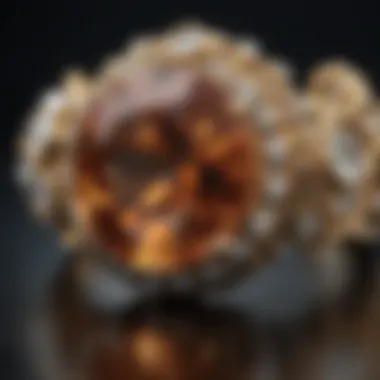
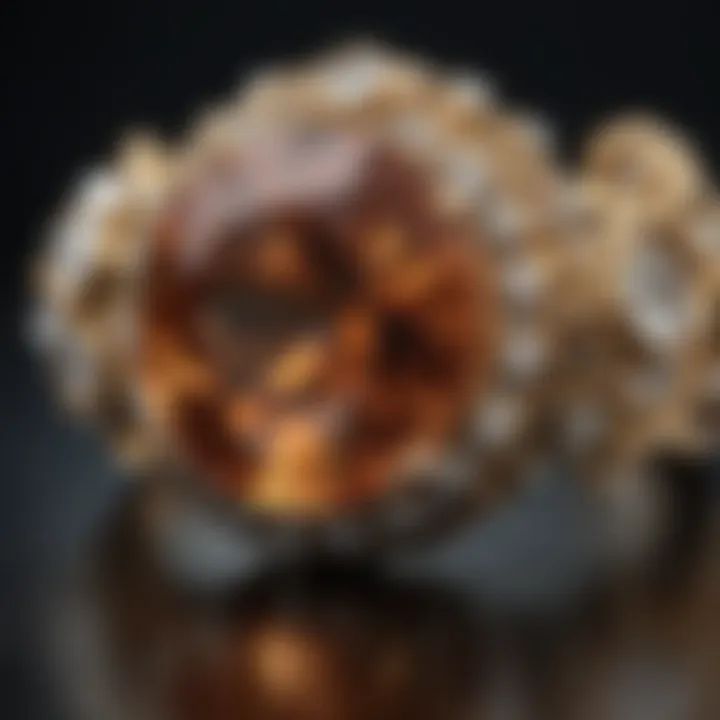
Within the spectrum of zircon, rare varieties emerge, marking a significant difference in value compared to more common forms.
"Rarity elevates the perceived value; collectors often chase after what’s not easily found."
- Color Change Zircon: This mesmerizing type can shift its color under different lighting conditions, often appearing blue in daylight and purplish under incandescent light. Due to its uncommonness, it is often priced significantly higher than its standard counterparts.
- Zircon with Unique Inclusions: Some specimens feature captivating inclusions, offering a glimpse into their geological history. The presence of these unique characteristics can boost value as they tell a rare tale of formation.
- Sphene Zircon: Similar to ordinary zircon but much rarer. With its unique high refractive index, it captures light and creates a vibrant sparkle, making it desirable among collectors.
When considering investment, both rarity and the specific variety play a critical role in determining the overall market value of zircon specimens. As has been noted, understanding these aspects enrichens not just the collecting experience but also appreciation for the mineral's broader context in geology.
Cultural Relevance
Cultural relevance of zircon is not merely confined to its physical beauty; rather, it is woven into the fabric of human history and belief systems. This section underscores the significance of zircon throughout various cultures, examining its historical context and the symbolism associated with it.
Zircon in History
Zircon can be traced back to ancient civilizations, making it a continuous thread in the timeline of human culture. Early records suggest that zircon was used as far back as the 13th century in Persia, known then as "zarkon." It's remarkable how this simple mineral played a role in adornments and amulets across cultures, signifying its intrinsic values. Many ancient cultures believed that zircon offered protection to the wearer.
In addition to its protective qualities, zircon has been adorned in royal crowns and ceremonial garb significantly in regions like Southeast Asia. For instance, during the Khmer Empire, zircon was a favored gemstone, often found in temples and royal artifacts. Such historical usage is key for anyone interested in rock and fossil collecting, as it ties the mineral back to both gemology and archaeology.
Symbolism and Beliefs
The symbolism surrounding zircon is rich and layered. In various cultures, it has been seen as a stone of wisdom and strength, thought to promote peace and tranquillity. Some traditions regard it as a good luck charm, believed to bring prosperity and success.
Apart from luck, zircon symbolizes integrity and strength in interpersonal relationships. This is due to the belief that it fosters honesty and loyalty among individuals. The deep connection between zircon and spiritual beliefs is also noteworthy. In the Hindu tradition, zircon is linked with the ether or space element, amplifying spiritual energies and promoting deep meditation.
As a collector, understanding the depth of meaning tied to zircon can increase the appreciation of their specimens.
"Zircon is not just a beautiful gem; it's a window into the life and beliefs of those who prized it centuries ago."
In summary, the cultural relevance of zircon extends far beyond its geological structure. It bridges history, symbolism, and functionality into one coherent narrative, enriching our understanding of this fascinating mineral. For collectors, recognizing this hidden cultural depth adds another layer to the passion for acquiring and preserving zircon specimens.
Preservation and Care
When dealing with minerals, especially those as distinct as zircon, understanding preservation and care is paramount. Proper techniques not only retain the beauty of zircon but also enhance its longevity. For rock and fossil collectors, ensuring that their specimens are well-maintained can significantly boost the overall value, both monetarily and sentimentally. Here’s a deep dive into cleaning techniques and storage recommendations.
Cleaning Techniques
Zircon's sparkling allure can easily be dulled by dust and grime, but cleaning it doesn't have to be a daunting task. Here are a few proven methods to keep your zircon looking as good as new:
- Gentle Soap Solution: Mix mild soap with lukewarm water. Soak your zircon for a few minutes and then use a soft brush to remove dirt. Rinse thoroughly and dry with a soft cloth. Avoid using harsh chemicals unless absolutely necessary, as they can damage the surface.
- Ultrasonic Cleaners: For a deeper clean, ultrasonic cleaners can be effective. However, use caution; make sure your zircon is durable enough for this type of cleaning. Generally, if it’s a flawless gem, the process is safe.
- Steam Cleaning: This is another effective method. Just as the name suggests, it uses steam to lift grime without physical abrasion. But, again, it’s essential to be cautious with more delicate pieces.
Storage Recommendations
Proper storage conditions for zircons can deter scratches and other forms of damage that may occur over time. Here are some key guidelines:
- Use Soft Pouches: Store your zircon in a soft pouch made of cloth to prevent scratches. Avoid wrapping them in paper towels as the fibers may cling to the surface and cause tearing.
- Jewelry Boxes with Dividers: For those who own several pieces, using a jewelry box with separate compartments is wise. This way, they won’t knock against each other and risk damage.
- Stable Environment: Store your zircon in a temperature-controlled environment. Extreme temperatures can affect the clarity and strength of the stone. Ideally, keep it away from direct sunlight to prevent fading.
- Moisture Control: While zircon is relatively resistant to moisture, it’s still a good idea to store them in a dry place. Silica gel packs can help absorb excess moisture if applied in enclosed spaces.
In summary, understanding the nuances of preserving and caring for zircon can make a world of difference. A little attention can ensure that your collection stays vibrant and retains its value through the years.
Future Perspectives
The future of zircon presents a fascinating landscape of possibilities in both the gemological and geological arenas. As interest continues to flourish in sustainable materials and innovative applications, zircon stands to gain attention not only as a gem but also as a significant resource in scientific research and industrial applications. This section dives into how zircon may shape its future by exploring its innovative uses and ongoing research developments.
Innovative Uses
Zircon's attributes lend themselves to a surprising number of modern applications, pushing beyond traditional jewelry usage. Researchers and manufacturers are continually finding inventive ways to harness zircon's unique properties. Here are a few areas where zircon is making waves:
- Advanced Ceramics: Zirconia, a derivative of zircon, is being employed in high-performance ceramics. With superior hardness and heat resistance, these materials are ideal for cutting tools and protective coatings, making them invaluable for industrial processes.
- Biomedical Applications: Zircon may play a crucial role in the development of dental implants and other biocompatible materials due to its durability and low reactivity. These applications show promise in enhancing patient outcomes and longevity of implants.
- Nuclear Energy: With an increasing focus on clean energy, zircon's stability under extreme conditions positions it as a key material in nuclear reactor designs. Its ability to withstand radiation and thermal stress makes it a prime candidate for further exploration in this field.
Additionally, researchers are beginning to look at zircon’s potential in education. Its complex crystalline structures can serve as excellent teaching aids in geology and mineralogy courses.
Research Developments
As the scientific community's understanding of zircon deepens, various research initiatives are emerging. Here are some promising trends that reflect its potential for future exploration:
- Geochronology Studies: Zircon is pivotal in age dating rocks and has become a cornerstone in understanding Earth's history. Ongoing studies are refining techniques for more accurate dating. Improved methods in analyzing zircon can lead to revelations about significant geological events, such as mass extinctions or tectonic shifts.
- Environmental Monitoring: Recent research considers zircon's capability as a geochemical marker for monitoring environmental changes. With climate change impacting our planet at an alarming rate, this intriguing application helps scientists understand pollution pathways and natural resource management.
- Nanotechnology: Emerging studies are exploring zircon at the nanoscale. This approach could spark innovations in electronics and renewable energy technologies. As materials become more sophisticated, the uses of zircon in nanotechnology could provide novel solutions in fields we have yet to fully explore.
"Zircon's multifaceted nature positions it as a vital resource, crossing the boundaries between geology, materials science, and biotechnology."



